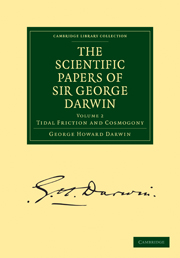Book contents
- Frontmatter
- PREFACE
- Contents
- Chronological List of Papers with References to the Volumes in which they are or probably will be contained
- Erratum in Vol. I
- TIDAL FRICTION AND COSMOGONY
- 1 On the Bodily Tides of Viscous and Semi-elastic Spheroids, and on the Ocean Tides upon a Yielding Nucleus
- 2 Note on Thomson's Theory of the Tides of an Elastic Sphere
- 3 On the Precession of a Viscous Spheroid, and on the Remote History of the Earth
- 4 Problems connected with the Tides of a Viscous Spheroid
- 5 The Determination of the Secular Effects of Tidal Friction by a Graphical Method
- 6 On the Secular Changes in the Elements of the Orbit of a Satellite revolving about a Tidally Distorted Planet
- 7 On the Analytical Expressions which give the History of a Fluid Planet of Small Viscosity, attended by a Single Satellite
- 8 On the Tidal Friction of a Planet attended by Several Satellites, and on the Evolution of the Solar System
- 9 On the Stresses caused in the Interior of the Earth by the Weight of Continents and Mountains
- INDEX
2 - Note on Thomson's Theory of the Tides of an Elastic Sphere
Published online by Cambridge University Press: 07 September 2010
- Frontmatter
- PREFACE
- Contents
- Chronological List of Papers with References to the Volumes in which they are or probably will be contained
- Erratum in Vol. I
- TIDAL FRICTION AND COSMOGONY
- 1 On the Bodily Tides of Viscous and Semi-elastic Spheroids, and on the Ocean Tides upon a Yielding Nucleus
- 2 Note on Thomson's Theory of the Tides of an Elastic Sphere
- 3 On the Precession of a Viscous Spheroid, and on the Remote History of the Earth
- 4 Problems connected with the Tides of a Viscous Spheroid
- 5 The Determination of the Secular Effects of Tidal Friction by a Graphical Method
- 6 On the Secular Changes in the Elements of the Orbit of a Satellite revolving about a Tidally Distorted Planet
- 7 On the Analytical Expressions which give the History of a Fluid Planet of Small Viscosity, attended by a Single Satellite
- 8 On the Tidal Friction of a Planet attended by Several Satellites, and on the Evolution of the Solar System
- 9 On the Stresses caused in the Interior of the Earth by the Weight of Continents and Mountains
- INDEX
Summary
The results of the theory of the elastic yielding of the earth would of course be more interesting, if it were possible fully to introduce the effects of the want of homogeneity of elasticity and density of the interior of the earth; but besides the mathematical difficulties of the case, the complete absence of data as to the nature of the deep-seated matter makes it impossible to do so. It is, however, possible to make a more or less probable estimate of the extent to which a given yielding of the surface will affect the ocean tide-wave, when the earth is treated as heterogeneous. And as we can only judge of the amount of the bodily tide in the earth by observations on the ocean tides, this estimate may be of some value.
The heterogeneity of the interior must of course be accompanied by heterogeneity of elasticity, and under the influence of a given tide-generating force, this will affect the internal distribution of strain, and the form of the surface to an unknown extent. The diminution of ocean tide which arises from the yielding of the nucleus is entirely due to the alteration in the form of the level surfaces outside the nucleus. But it is by no means obvious how far the potential of the earth, when its surface is distorted to a given amount, may differ from that of the homogeneous spheroid considered by Sir W. Thomson; and in face of our ignorance of the law of internal elasticity, the problem does not admit of a precise solution.
- Type
- Chapter
- Information
- The Scientific Papers of Sir George DarwinTidal Friction and Cosmogony, pp. 33 - 35Publisher: Cambridge University PressPrint publication year: 2009First published in: 1908

